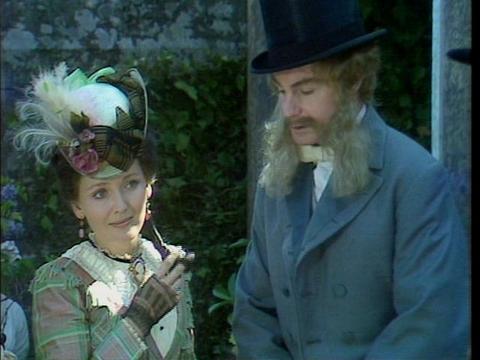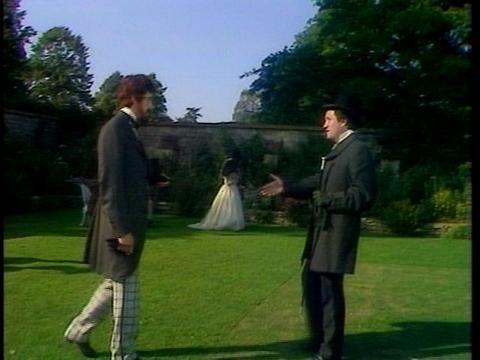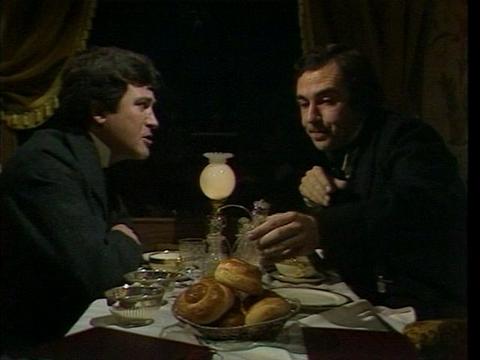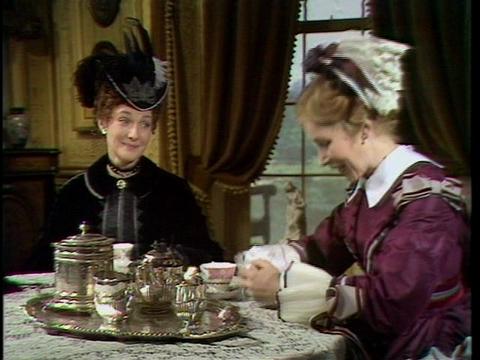Ellen and Jim Have a Blog, Too
We are two part-time academics. Ellen teaches in the English department and Jim in the IT program at George Mason University.


Pallisers 6:11: Change of mood to satire; how to erase even proto-feminism · 20 May 08
Dear Readers,
A fourth blog on 6:11. As I come up to the third major novel (or matter) that makes up the Palliser films, The Eustace Diamonds, I’m beginning to see Raven writes the Lizzie Eustace (Sarah Badel) and Lord Fawn (Derek Jacobi) matter from a different stance or mood, and produces a different tone and type character than he did with the first two matters, the Plangenet (Philip Latham) and Lady Glencora (Susan Hampshire) Palliser story (SHA and CYFH?) and the Phineas/Lady Laura (Donal McCann/Anna Massey) story (PF).
There was a striking change of of mood and structure when we left the Plantagenet/Lady Glen & Vavasour/Grey (Caroline Mortimer, Gary Watson and Bernard Brown) stories (SHA & CYFH) behind to find ourselves in the Phineas matter (PF and PR). From 1:1 to 3:51 the mood is serious, grave romance, often tragic: we see central individual loss, grief, and destruction of a key character (Burgo Fitzgerald [played by Barry Justice]) and compromise for the other two (Plantagenet and Lady Glen) which requires they give up something central to their sense of self—not permanently for the series marches on. We have two outcasts and violence and death.
At 3:6 we experience our transition and find ourselves in a plot-design ultimately comic, or tragi-comic and sentimental: Phineas’s story taken over the long haul (it ends in 9:19) is one of hard-won success as is his final partner, the secondary heroine of the series, Madame Max (Barbara Murray). The structure becomes that of a quest, inward and outward to integrate into the group and achieve high place to do something useful. There is the smaller story which has a semi-comic close in compromise and not loss but staying with the characters’ deeper values (Chiltern and Violet [John Hallam and Mel Martin], anti-politics) and a parallel with Lady Laura, another tragedy to be sure, and she ends an exile—as Phineas almost does. She fails in her quest because she misunderstood her options as a woman. All the stories have real heroines and heroes we are to like, sympathize with, admire, even love.
Not the Lizzie Eustace and Fawn story. Raven has turned to satire. This third story is low satire. Not only no hero in sight, but our chief male, Fawn, is what classicists call an “eiron” figure, a self-deprecating figure who coresponds to the Omphale archetype: the male dominated and bullied by women. I’d call this ironic satire too as Raven does not believe without much qualification in social norms as good or virtuous; rather (as Northup Frye says in his discussion of satire), Raven’s world in the Lizzie Eustace/Fawn mater (and elsewhere, shot through the series) is one filled with “anomalies, injustices, follies, crimes.” Anyone who wants to survive had first of all learn to be quiet, say nothing to maintain your balance as a start (Frye, Anatomy of Criticism, 223-226) I would say satire in Raven is not gay (gay satire accepts conventions and likes them, stresses tolerance, flexibility—Etherege’s Man of Mode, a play I recently read is like this); in Raven attack predominates. Blocking characters are in charge of society (the Duke of Omnium [Roland Culver], Lady Glen who controls him); Raven is not after hypocrisy which he accepts, but is content to create burlesques.

Lizzie Eustace (Sarah Badel) meeting the Duke and Lady Glen is all sweet hypocrisy, Lord Fawn (Derek Jacobi) all discomfort. He clearly has what Jane Smiley has (in her Decameron Ten Days In the Hills) recently wittily labeled “the manliness problem” in movies.
There is no plain dealer (to use a term from William Wycherly, a Restoration playwright satirist), the outspoken advocate of integrity. My sense is the closest Raven comes to a plain dealer is Chiltern. The malcontent or railer (also discussed in Frye, Anatomy of Criticism, p 176) is integrated by the comic line of Phineas’s story; Phineas and he come together:

Phineas (Donal McCann) offers to shake Chiltern’s (John Hallam) hand, after Chiltern has tried to kill him in a duel
And Phineas rejects the true hypocrite in the end, Laurence Fitzgibbon (Neile Stacey) who after painful experience and an insulting argument Phineas realizes is not worth his time & certainly not going into debt for

Laurence Fitzgibbon (Neil Stacey) as ever too intent on fullfilling his appetites to listen to anyone else’s ideas or needs
How does Lizzie Eustace, fit in here? She’s a failed femme fatale, ultimately as stupid as Fawn. Although she attempts to bully and lies to get what she wants, and Lord Fawn allows himself to be bullied to keep up hollow appearances (this is part of Trollope’s conception of these characters), she allows herself to chose badly when it comes to an engagement and worse when it comes to marriage. The series is not antisemitic as all mention of Emilius’s Jewishness is simply removed. Trollope’s novel is viscerally antisemitic, Joseph Emilius (Anthony Ainley) is a bad crook, a bigamist turned hypocritical clergyman and then dastardly murderer. But Lizzie is left somewhat similar: in both Trollope and Raven, she makes herself miserable from her obsession, for she gains nothing but admiration not worth having, and then lies to the police when it was stolen so involved herself in a crime. Raven understands he cannot center a TV film on a heroine we are to hate and despise and so he turns her into a petty coquet; Sarah Badel plays the part as Lizzie wanted herself to be seen through her powetry: a shepherdess in a pastoral, a nymph. I’m not sure yet what to make of her; in front of the Duke she was merely obvious, transparently flattering him. I found her ridiculous (in all sense of the word) towards the end of her story in the film (as I recall). She’s very vulgar (satire turns people into animals)
The obscenity so typical of satire (Frye, p 235) is found in the parallel to Fawn, the Duke of Omnium: he acts lecherously and runs after his nurse and has to be quieted .I really disliked the way Raven’s Lady Glen treated that nurse (fired her I think). Also in Fawn’s lack of masculinity, those long whiskers are symbols of his lack of masculinity; they look like long hair (hair is often obscene, as in Pope’s famous Rape of the Lock—imagine pulling Fawn’s?).
What then is the plot-design? In satire there is often none; it is often utterly mixed as the terms for it imply (think of Gulliver’s Travels). Of course part of the idea is to deny that design or meaning exists (Gilbert Highet, Anatomy of Satire, p 12). Of course Raven has ready to hand the detective tory/diamond theft plot-design to go with and uses that. I’m going to try to see if there’s a pattern or structure or plot-design in 6:12-7:14 (the basic parts which contain what’s left of Eustace Diamonds). Studying the films some more, it’s become more obvious how small a time span in the series Raven gave over to The Eustace Diamonds. Phineas matter 1 (Phineas Finn) doesn’t really end until 6:12, and the Lizzie Eustace and Lord Fawn story only dominates for in 7:13 as by 7:14, the Phineas matter has taken over again (the death of Mary and her baby and Phineas’s troubles upon his return of Phineas begin in 7:14). Thus not much plot-design is needed; it can be provided for by emphasizing what’s marginalized in the book: the choral scenes where the Palliser characters discuss what’s happening in the rest of the novel, tell us about their lives and refer to politics. Their story is on hold while they amuse themselves talking of and we watch the hollow useless Lizzie attempt to hold onto her necklace, and her weak gulled suitors and those who seek to live off her muddled existence.
One can read Trollope’s Eustace Diamonds, against the grain albeit, as a proto-feminist book, but one can only do this if one includes all the women, especially the counterheroine, Lucy Morris, and the “real” heroine (as Trollope our narratorironically tells us), Lucinda Roanoke who is driven mad by her unacknowledged mother’s harassment to marry a violent mean man. Raven has erased both. An unmuddled moral point of view that sees Lizzie as both a moral horror and a survivor only emerges if you put her in the context of all the women of the book – and that even includes the choral figures, Madame Max now nurse to the old lecherous man, and Lady Glen, now having done all her duty to breed heirs and having circumvented Madame Max in the area of marriage.
Instead we get this male satire, the burlesque anti-Hercules mode, with Frank Greystock (Martin Garvis) a deluded cypher, and Lord Fawn set up as an ass in the center, and male anxieties given full reign in laughter at the male meant to comfort by in the case of Fawn suggesting to the viewer oh no you’re not like this at all, not to worry.
It’s also fascinating that the conflict begun in 1:1, with the Duke demanding his heir marry a woman who in money and class suits the family interest, and Lady Glen bullied and frightened into the marriage, climaxes first in 5:10 in a stand-off between two women: neither powerful; one coerced into marriage (Lady Glen), the other a fringe person, mocked and in danger of ostracization all the time (Madame Max), held up just by her money from the “source” that potentially pollutes her (if you take the taboos about sex and virginity seriously). Then the issue of Lady Glen’s ambition or compensation (her reward for in her words in the film “keeping to her duty”) is again temporarily resolved when in 6:11, Madame Max says no to the Duke in return for Lady Glen’s friendship.

Lady Glen (Susan Hampshire) listening to Madame Max, now called Marie (Barbara Murray) telling Lady Glen that Madame Max is not the only woman in the world; the Duke may look for another. Lady Glen replies she will then consult Marie.
Yet all these women need to be contracted to society in some way and that is through marriage, sexual alliances (as Carole Pateman has shown in her The Sexual Contract) so a final ending to the second part of the Phineas matter in the film (9:19) is Madame Max marrying Phineas (as she does in the closing pages of Trollope’s Phineas Redux). We see here how women are coopted into the male hegemonic order will she nill she. In Trollope’s Phineas Finn where the politics keeps the dominant note, the ending is Phineas’s fall and the ironic offer of a job (grabbed by Phineas) inspecting poor houses for a 1000 pound, with John Millais’s final illustration of Phineas at a home-y table relieved to read the offer in a letter from Lord Cantrip in front of Mary (an exact replica of the final illustration of Trollope’s Last Chronicle where of Josiah Crawley is decidedly not relieved to read an analogous letter from Archbishop Grantley in front of Mrs Crawley.
The film, folk art, presents this image of women as the powerful figures repeatedly—we see this in Barchester Chronicles too. Wishfulfillment or bringing out what is not visible for the woman viewer—these mini-series are seen as women’s films.
1 See various links and a concise summary of 1:1-3:6, 4:7, 4:8, 5:9, and 5:10.
Ellen
--
Posted by: Ellen
* * *
Comment
- In an oocytical (foundational?) book, Molly Haskell’s From Reverence to Rape, demonstrated that most women’s roles or archetypes in the films are a projection of men’s ideas about women and reflect men’s experience and attitudes towards society. In one chapter on movies of the 1940s she famously went into the development of a very few “strong” women archetype who defy the usual stereotypes of “good” woman (daughter, mother, wife, sister—Lady Glen in our film, made passive and reactive) and “bad” (prostitute, domineering, man-trapping, the repressed mother) or a surrogate for male (in a detective action role or the side-kick of such a male). She fixed on several actresses who made careers from enacting these roles and famous characters from well-known popular movies. Tellingly she divided the types into European and North American (US and Canada) and argued that the type which haunts the minds of film-makers in Europe is the superfemale: Hedda Gabler in literature and in film, Vivien Leigh, Bette Davis. The superfemale is someone who doesn’t marry or doesn’t get her power from marriage but is seen to be powerful, and utterly feminine; she is sexual and yet not to be used by just anyone, a user of sophisticated mores to manipulate, highly theatrical in her self-presentation, but ever quiet (this is a man’s ideal), not obviously aggressive (ditto), flirting in an intellectual interesting way, and beautiful, fine fashion.
The American strong woman was identified by Haskell as the superwoman, and she was someone who went to work, who had a career and vied with her man through money earning and power, ambitious in the marketplace. Katherine Hepburn playing a lawyer against Spencer Tracey, Rosalind Russell; she is not overtly sexy, not intellectual particularly, not elegant. His Girl Friday, Adam’s Rib. Of course types combine and we find aspects of this type in Jean Arthur’s roles. Here the folk mythology pays tribute to the enterprising woman.
In a later blog on the Palliser series I will show how this typology works out in Raven’s Palliser films covering Eustace Diamonds and Phineas Redux (aka Lizzie Eustace and Madame Max [Marie] Goesler).
Ellen
— Elinor May 20, 8:05am # - One last comment on 6:11, the second scene where Lizzie Eustace meets the Duke of Omnium (pictured on the blog):
I’ve noticed each time we meet a new truly major character (Plantagenet, Dolly, Lady Glen, Burgo, Alice Vavasour, George Vavasour, Phineas Finn, Madame Max Goesler, Lady Laura Standish), soon after we get a focused moment where the character is presented in a sunlit moment and at their best and looking youthful and hopeful. Never underestimate the film-makers’ understanding that people watching movies want to be cheered and flattered.
So here for the first time we get to watch Lady Glencora Palliser (Susan Hampshire) meet Lizzie Eustace (Susan Badel) and Lord Fawn (Derek Jacobi), it’s the usual sunlit moment:
http://groups.yahoo.com/group/trollope-l/
The Duke (Roland Culver) looks on from the side. The dialogue just then has Lizzie as a sort of idyllic nymph/shepherdess with Lord Fawn all kind courtesy. The hard note is hit when the Duke brings up in a salacious tone his memories of Horace Greystock. Horace is Raven’s addition. Trollope does not give Admiral Greystock (Lizzie’s father) a first name. Doubtless an allusion to the classical poet Horace and how Raven saw him: someone who enjoyed life sensually, the Horatian retreat ideal becoming something far more libertine than usual.
Films are folkart and popular films create characters out of archetypes where the actor’s psychological baggage is carried from film to film. I don’t know enough about Sarah Badel’s career (women usually have a much shorter one), but Claudius has aspects which fit Raven’s conception (only ridiculed strongly by Raven as Graves nor the adaptor ridicule Claudius). And Susan Hampshire is every the upper class Englishman’s dream high status wife—she resembles Celia Johnson in her facial features and both the type in the original illustrations to Trollope’s novels.
Ellen
— Elinor May 20, 8:06am #
commenting closed for this article
